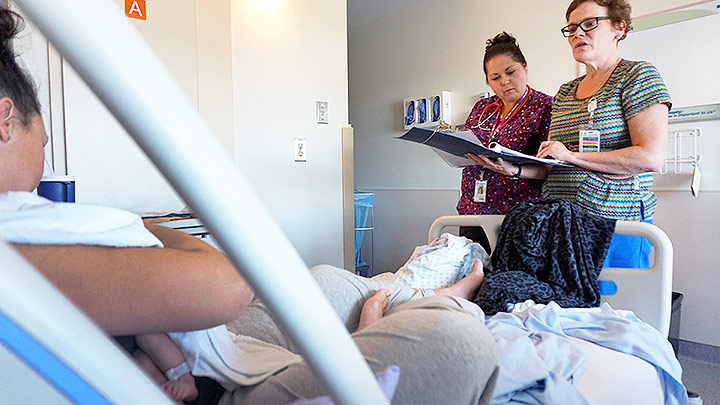
January 16, 2017

Licensed practical nurses Marcy Kaminski, left, and Karen Hillis review a patient’s chart as part of the Patient Handover At Bedside initiative to ensure a smooth transition between shifts.
Story by: Heather Kipling
RED DEER — When in hospital, patients will inevitably find themselves being cared for by many members of their healthcare team.
To help transition the care of patients between nursing shifts, the postpartum unit at Red Deer Regional Hospital Centre has introduced a new way of doing things.
Through their Patient Handover At Bedside (PHAB) initiative, staff have improved how patient care is transferred from one shift to another, while ensuring that patients are included in the process.
“We used to hear patients say they weren’t sure who was caring for them, so we knew we needed to make a change,” says registered nurse Derilee Ziebart, who was part of the PHAB working group.
The group, which brought together nurses, unit leadership, educators and guidance from the Clinical Quality Improvement team, drew on the experiences of other sites in their planning.
“We visited the Grey Nuns Community Hospital in Edmonton to see how they do patient handovers right at the bedside, so patients are aware and involved in the process when a new nurse comes on shift,” explains Ziebart.
“From them, we were able to adopt ideas and practices to improve our own approach so that when there is a shift change, patient reports are discussed at the bedside. This way, the nurse just starting a shift can meet the patient and their family, as well as get the latest care report and patient history.”
Previously, reports between nurses at shift change were done outside the patient room with less involvement from patients.
In addition to the PHAB initiative, whiteboards have been installed in patient rooms as a consistent source of information for both patients and staff. As well, comfort rounds have been introduced.
And while a whiteboard may seem like a simple change, it’s having a big impact.
“The information board in the room is awesome,” reads one patient response, while other patients have noted they “like the boards in the room with the nurse’s name on it.”
“The new whiteboard system is one of the steps we took to improve patient- and family-centred care,” says clinical educator Suzanne Koopmans. “It’s important for patients, their family and the nursing team to have good communication about a patient’s care. The use of the whiteboards provides important, helpful information including the names of the patient’s doctor, their care team, discharge date and care plan for the day.
“It helps transfer information effectively and helps patients stay engaged and informed.”
The unit also introduced comfort rounds to further improve patient care.
“Comfort rounds occur in the last hour of a shift. They give staff time to check back with their patients to ensure their care needs are met. This addresses personal needs, pain, preparation for shift change and their environment,” says quality consultant Emma Currie, who helped lead the project on the unit.
“All the steps that have been taken make for a streamlined process that keeps patients engaged in their care. It also enhances the teamwork on the unit, which benefits not only staff but patients and their families.”